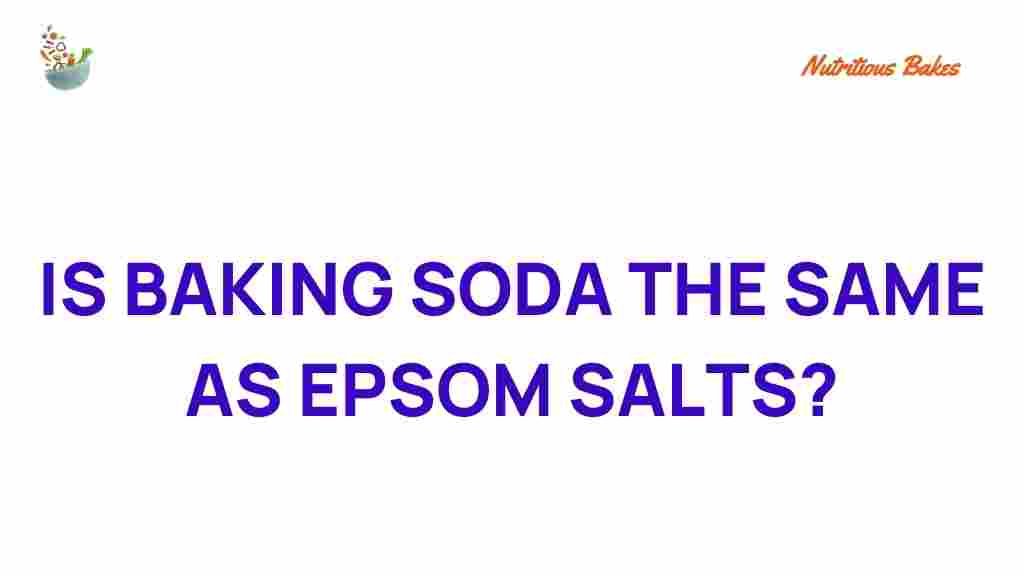Unraveling the Mystery: Is Baking Soda the Same as Epsom Salts?
When it comes to household remedies, many people often find themselves confused about the different products available for cleaning, cooking, and health benefits. Two commonly used substances that frequently stir up curiosity are baking soda and Epsom salts. While both are versatile ingredients, they serve different purposes and have unique properties. In this article, we will explore the differences between baking soda and Epsom salts, their uses, and how they can benefit your home and health.
What is Baking Soda?
Baking soda, scientifically known as sodium bicarbonate, is a white crystalline powder that is widely used in cooking, cleaning, and various home remedies. Its alkaline properties make it a popular ingredient for:
- Baking: Acting as a leavening agent to help baked goods rise.
- Cleaning: A gentle abrasive that can help scrub surfaces without scratching.
- Deodorizing: Neutralizing odors in refrigerators, carpets, and more.
- Health Benefits: Used in remedies for heartburn and indigestion.
What are Epsom Salts?
Epsom salts, or magnesium sulfate, are crystalline minerals that have been used for centuries for their therapeutic properties. They are most commonly known for:
- Relaxation: Often added to baths to soothe sore muscles and promote relaxation.
- Gardening: Used to provide magnesium to plants, enhancing growth.
- Health Benefits: Believed to help with inflammation and stress relief when absorbed through the skin.
Differences Between Baking Soda and Epsom Salts
While both baking soda and Epsom salts are used in various household remedies, their chemical composition and functions differ significantly. Here’s a breakdown of their key differences:
Chemical Composition
Baking soda is comprised of sodium and bicarbonate ions (NaHCO₃), whereas Epsom salts are made up of magnesium, sulfur, and oxygen (MgSO₄·7H₂O). This fundamental difference in composition leads to varying uses and benefits.
Primary Uses
The primary uses of baking soda and Epsom salts can be categorized as follows:
- Baking Soda:
- Cooking and baking as a leavening agent
- Cleaning household surfaces
- Neutralizing odors
- Personal care, such as toothpaste or exfoliant
- Epsom Salts:
- Soaking in baths for muscle relaxation
- Gardening to improve plant health
- Foot soaks to relieve soreness
- Detoxifying skin in spa treatments
Health Benefits
Both baking soda and Epsom salts offer health benefits but in different forms:
- Baking Soda:
- Alleviates heartburn and indigestion when mixed with water.
- Can act as an antacid.
- May help reduce acne when used in a paste.
- Epsom Salts:
- Relieves muscle tension and soreness when dissolved in warm water.
- May help reduce stress and promote better sleep.
- Can improve magnesium levels in the body.
Uses of Baking Soda and Epsom Salts
Understanding the various uses of baking soda and Epsom salts can help you make the most of these versatile ingredients:
In Cooking
Baking soda is primarily used in cooking as a leavening agent. When combined with acidic ingredients, it produces carbon dioxide gas, causing doughs and batters to rise. Epsom salts, on the other hand, are not used in cooking due to their bitter taste and high magnesium content.
For Cleaning
Both substances can be effective cleaning agents, but they function differently:
- Baking Soda:
- Sprinkle on carpets before vacuuming to absorb odors.
- Mix with water to create a paste for scrubbing surfaces.
- Use to deodorize refrigerators and trash cans.
- Epsom Salts:
- Can be mixed with vinegar to create a cleaning scrub.
- Effective for cleaning bathroom tiles and grout.
- Use in laundry as a fabric softener alternative.
As Household Remedies
Both baking soda and Epsom salts can be used in various household remedies:
- Baking Soda:
- Mix with water to create a paste for treating insect bites.
- Add to bathwater to soothe skin irritations.
- Epsom Salts:
- Create a foot soak with warm water and Epsom salts for tired feet.
- Use in baths to relieve muscle pain after exercise.
Step-by-Step Process for Using Baking Soda and Epsom Salts
Here’s a simple guide on how to use both ingredients effectively:
How to Use Baking Soda
- For Baking: Combine baking soda with acid (like vinegar or lemon juice) in your recipe.
- For Cleaning: Sprinkle baking soda on the surface, scrub with a damp cloth, and rinse.
- As a Deodorizer: Place an open box of baking soda in your refrigerator or sprinkle on carpets before vacuuming.
How to Use Epsom Salts
- For a Relaxing Bath: Dissolve 2 cups of Epsom salts in warm bath water and soak for 15-20 minutes.
- For Foot Soaks: Mix 1 cup of Epsom salts in a basin of warm water and soak your feet for 15-30 minutes.
- In Gardening: Sprinkle Epsom salts around your plants or dissolve in water to nourish them.
Troubleshooting Tips
When using baking soda and Epsom salts, you may encounter some common issues:
If Baking Soda Doesn’t Work as Expected:
- Ensure it is fresh. Baking soda loses potency over time.
- Check the acidity of your recipe if baking; it may need more acid to activate.
If Epsom Salts Do Not Dissolve Properly:
- Make sure to use warm or hot water for dissolving.
- Stir well to ensure complete dissolution before soaking.
Conclusion
In conclusion, while both baking soda and Epsom salts are versatile ingredients found in many households, they serve distinct purposes and have different health benefits. Baking soda is primarily used in cooking, cleaning, and as a home remedy, while Epsom salts are more focused on relaxation and therapeutic uses. By understanding their unique properties and applications, you can maximize their benefits in your daily life.
For more information on household remedies and versatile ingredients, check out this guide on natural cleaning solutions. If you’re looking to explore the health benefits further, you can visit this resource on Epsom salts and wellness.
This article is in the category Ingredients and created by NutritiousBakes Team
